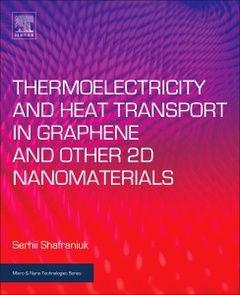Description
Thermoelectricity and Heat Transport in Graphene and Other 2D Nanomaterials
Micro and Nano Technologies Series
Author: Shafraniuk Serhii
Language: English
Subjects for Thermoelectricity and Heat Transport in Graphene and...:
Keywords
K-point; alloying; atomic monolayers; Boltzmann transport equation; carbon nanotubes; chiral fermion scattering; CNT quantum dot; convective heat transfer; cooling power; dielectric function; double resonance; dynamical random phase approximation; effective mass equations; electron-electron interaction; electron-phonon interaction; electronic thermal transport; energy sensitivity; few-layer graphene; field effect transistor; figure of merit; gate doping; heat flux transistor; heavy adatoms; indirect excitons; intrinsic temperature; Kohn anomalies; lattice oscillations; lattice thermal conductivity; many body; Matthiessen's rule; molecular vibrations; nanodevices; nanopores; nanoscale; nanoscale cooling; nanostructuring; optical susceptibility; optothermal Raman measurement; phonon Boltzmann equation; phonon boundary scattering; phonon drag; phonon relaxation rates; phonon spectrum; phonon transport; photo-thermoelectric response; photon-assisted tunneling; plasma oscillations; quantization; quantum theory; Raman scattering; retardation effects; reversible Peltier effect; scattering in two dimensions; self-energy; spectral analyzers; Stokes and anti-Stokes scattering; structural defects; thermal and electric transport; thermal flux; thermal management; thermoelectric transducer; THz domain; THz field; THz field-induced cooling; Tomonaga-Luttinger liquid; topologically protected states; transduction efficiency; transient heat transfer; transition-metal dichalcogenides; Wannier-Mott excitons
Support: Print on demand
Description
/li>Contents
/li>Readership
/li>Biography
/li>Comment
/li>
Thermoelectricity and Heat Transport in Graphene and Other 2D Nanomaterials describes thermoelectric phenomena and thermal transport in graphene and other 2-dimentional nanomaterials and devices. Graphene, which is an example of an atomic monolayered material, has become the most important growth area in materials science research, stimulating an interest in other atomic monolayeric materials.
The book analyses flow management, measurement of the local temperature at the nanoscale level and thermoelectric transducers, with reference to both graphene and other 2D nanomaterials. The book covers in detail the mechanisms of thermoelectricity, thermal transport, interface phenomena, quantum dots, non-equilibrium states, scattering and dissipation, as well as coherent transport in low-dimensional junctions in graphene and its allotropes, transition metal dichalcogenides and boron nitride.
This book aims to show readers how to improve thermoelectric transducer efficiency in graphene and other nanomaterials. The book describes basic ingredients of such activity, allowing readers to gain a greater understanding of fundamental issues related to the heat transport and the thermoelectric phenomena of nanomaterials. It contains a thorough analysis and comparison between theory and experiments, complemented with a variety of practical examples.
I. LOW-ENERGY ELECTRON EXCITATIONS IN GRAPHENE1. Dirac equation for chiral fermions2 Tight binding scheme3. Berry phase and topological singularity in graphene4. Klein paradox and chiral tunnelling
II. THERMAL TRANSPORT OF CHARGE CARRIERS1. Components of the heat transport2. Modelling of heat transport of charge carriers in graphene and carbon nanotube devices3. Quantum confined Stark effect4. PT-invariance the Dirac Hamiltonian5. Heavy chiral fermions at zigzag edges of graphene stripe
III. PHONON TRANSPORT AND HEAT CONDUCTIVITY1. Phonon modes in the two-dimensional graphene2. Phonon spectra in graphene, and graphene nanoribbons 3. The phonon transport in two-dimensional crystals4. Momentum diagram of phonon transport in graphene5. Thermal conductivity due to phonons in graphene nanoribbons
IV. EXPERIMENTAL STUDY OF THE THERMAL TRANSPORT1. Raman scattering2. Role of the degrees of freedom3. Molecular vibrations and infrared radiation4. Various processes of light scattering5. Stokes and anti-Stokes scattering6. Raman scattering versus fluorescence7. Selection rules for Raman scattering8. Raman amplification and Stimulated Raman scattering 9. A requirement of the coherence10. Practical applications11. Higher-order Raman spectra 12. Raman spectroscopy of graphene 13. Kohn anomalies, double resonance, and D and G peaks 14. Deriving the electron–phonon coupling from Raman line width 15. Raman spectroscopy of graphene and graphene layers 16. Failure the adiabatic Born–Oppenheimer approximation and the Raman spectrum of doped graphene17. Influence of the atomic and structural disorders18. Graphene ribbons and edges
V. ROLE OF STRUCTURAL DEFECTS AND IMPERFECTIONS1. Pseudospin conservation during the scattering of chiral fermions 2. Phonon drag effect3. Screening by interacting electrons4. Plasma oscillations5. Plasma excitations in graphene6. Electron-impurity scattering time in graphene7. Scattering of phonons in a few-layer graphene
VI. MANY BODY EFFECTS IN GRAPHENE 1. Electron-electron interaction2. Electron self-energy effects3. Quasi-particle excitations 4. Numeric results5. Excitons in graphene and in the other atomic monolayers6. Wannier-Mott excitons7. Excitonic states8. Experimental observation of excitons in graphene and in the other atomic monolayers9. Electron scattering on indirect excitons10. Tomonaga–Luttinger liquid11. Probing of intrinsic state of one-dimensional quantum well with a photon-assisted tunneling12. The TLL tunneling density of states of a long quantum well13. Identifying the charge and the spin boson energy levels14. Useful relationships
IX. THERMOELECTRIC DEVICES BASED ON GRAPHENE AND OTHER ATOMIC MONOLAYERS1. Thermoelectric phenomena on nanoscale2. Performance and efficiency of the thermoelectric device 3. Quantum theory of electronic thermal transport 4. Electron transport and elastic collisions5. Reversible Peltier effect in carbon nano-junctions6. Thermoelectric figure of merit and Fourier law7. Phonon Transport and Thermal Conductivity8. Recent experiments for measuring the thermal conductivity of graphene9. Microscopic model of the thermoelectric effect10. Converting the heat into electricity by a graphene stripe with heavy chiral fermions11. Blocking the phonon flow by multilayered electrodes12. Molecular dynamics simulations13. Non-equilibrium thermal injection16. Perspectives of Thermoelectric Research for Graphene
XI. OTHER ATOMIC MONOLAYERS 1. Heat transport in atomic monolayers2. A few-layered materials3. Electric transport in nanodevices4. Electronic transport versus scattering mechanisms5. TMDC thermoelectric devices 6. Perspectives of the TMDC transducers 7. Vibrational and optical properties of TMDCs8. The future thermolectric applications of 2D materials
Materials scientists, solid state physicists and engineers working in the areas of carbon nanomaterials and seeking to increase their efficiency with a view to industrial application.
- Shows readers how to improve the efficiency of heat transfer in graphene and other nanomaterials with analysis of different methodologies
- Includes fundamental information on the thermoelectric properties of graphene and other atomic monolayers, providing a valuable reference source for materials scientists and engineers
- Covers the important models of thermoelectric phenomena and thermal transport in the 2D nanomaterials and nanodevices, allowing readers to gain a greater understanding of the factors behind the efficiency of heat transport in a variety of nanomaterials




